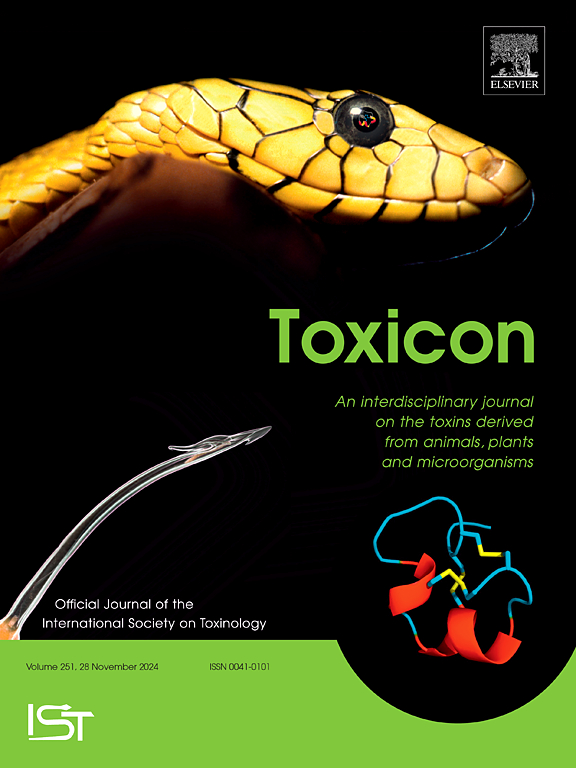使用血管紧张素转换酶抑制剂的响尾蛇中毒后的全身毒性:一项北美蛇咬伤登记研究。
IF 2.6
4区 医学
Q2 PHARMACOLOGY & PHARMACY
引用次数: 0
摘要
背景:一些北美响尾蛇毒液和血管紧张素转换酶抑制剂(ACEI)药物都会增加人体内的缓激肽水平,临床效应可归因于暴露人群中的缓激肽。接触ACEI对蛇中毒患者的影响尚未研究。我们使用来自ACMT北美蛇咬伤登记(NASBR)的数据来确定在响尾蛇中毒时使用ACEI药物是否与全身毒性发生率增加有关。方法:纳入2013年1月1日至2021年12月31日在NASBR中录入的响尾蛇毒液。提取的数据包括患者人口统计、病史、临床和实验室结果、治疗和结果。使用ACE抑制剂的患者(ACEI组)与未使用ACEI的患者(无ACEI组)进行比较。主要结局包括全身性毒液作用,次要结局包括住院时间和抗蛇毒血清总剂量(Fab和F(ab')2)。结果:共收录响尾蛇毒液817例。ACEI组43例(5.3%),No ACEI组774例(94.7%)。两组间抗蛇毒血清反应时间和急性超敏反应时间无差异。ACEI组低血压发生率(18.6%)高于无ACEI组(6.5%;p = 0.008)。与无ACEI组相比,ACEI组腹泻发生率更高(11.6%)(2.1%;p = 0.003)。然而,两组之间的总体系统毒性没有显著差异(25.6% ACEI vs. 17.4%无ACEI, p=0.25)。结论:在NASBR中,使用乙酰胆碱酯酶的患者在响尾蛇中毒后比不使用乙酰胆碱酯酶的患者更容易出现低血压和/或腹泻;然而,两组之间的总体系统毒性没有显著差异。本文章由计算机程序翻译,如有差异,请以英文原文为准。

Systemic toxicity after rattlesnake envenomation in patients using angiotensin converting enzyme inhibitors: A North American Snakebite Registry study
Background
Some North American rattlesnake venoms and angiotensin converting enzyme inhibitor (ACEI) medications each increase bradykinin levels in humans, with clinical effects attributable to bradykinin described in exposed populations. Influence of ACEI exposure on persons with snake envenomation has not been studied. We used data from the ACMT North American Snakebite Registry (NASBR) to determine if use of ACEI medications at the time of rattlesnake envenomation is associated with increased rate of systemic toxicity.
Methods
Rattlesnake envenomations entered in the NASBR between January 1, 2013 and December 31, 2021 were included. Data extracted included patient demographics, medical history, clinical and laboratory findings, treatments, and outcomes. Patients who use ACE Inhibitors (ACEI group) were compared to patients without ACEI use (No ACEI group). Primary outcomes included systemic venom effects and secondary outcomes included length of stay and total number of antivenom vials administered (for Fab and F (ab')2).
Results
817 rattlesnake envenomations were included. Forty-three (5.3%) were in the ACEI group and 774 (94.7%) in the No ACEI group. There were no differences in time to antivenom or acute hypersensitivity reactions between groups. Hypotension was more frequent in the ACEI group (18.6%) compared to the No ACEI group (6.5%; p = 0.008). Diarrhea also occurred more frequently in the ACEI group (11.6%) compared to the No ACEI group (2.1%; p = 0.003). However, overall systemic toxicity did not significantly differ between the two groups (25.6% ACEI vs. 17.4% no ACEI, p = 0.25).
Conclusions
In the NASBR, patients who use ACEIs are more likely to experience hypotension and/or diarrhea after rattlesnake envenomation than are patients who do not use ACEIs; however, overall systemic toxicity did not significantly differ between the two groups.
求助全文
通过发布文献求助,成功后即可免费获取论文全文。
去求助
来源期刊

Toxicon
医学-毒理学
CiteScore
4.80
自引率
10.70%
发文量
358
审稿时长
68 days
期刊介绍:
Toxicon has an open access mirror Toxicon: X, sharing the same aims and scope, editorial team, submission system and rigorous peer review. An introductory offer Toxicon: X - full waiver of the Open Access fee.
Toxicon''s "aims and scope" are to publish:
-articles containing the results of original research on problems related to toxins derived from animals, plants and microorganisms
-papers on novel findings related to the chemical, pharmacological, toxicological, and immunological properties of natural toxins
-molecular biological studies of toxins and other genes from poisonous and venomous organisms that advance understanding of the role or function of toxins
-clinical observations on poisoning and envenoming where a new therapeutic principle has been proposed or a decidedly superior clinical result has been obtained.
-material on the use of toxins as tools in studying biological processes and material on subjects related to venom and antivenom problems.
-articles on the translational application of toxins, for example as drugs and insecticides
-epidemiological studies on envenoming or poisoning, so long as they highlight a previously unrecognised medical problem or provide insight into the prevention or medical treatment of envenoming or poisoning. Retrospective surveys of hospital records, especially those lacking species identification, will not be considered for publication. Properly designed prospective community-based surveys are strongly encouraged.
-articles describing well-known activities of venoms, such as antibacterial, anticancer, and analgesic activities of arachnid venoms, without any attempt to define the mechanism of action or purify the active component, will not be considered for publication in Toxicon.
-review articles on problems related to toxinology.
To encourage the exchange of ideas, sections of the journal may be devoted to Short Communications, Letters to the Editor and activities of the affiliated societies.
 求助内容:
求助内容: 应助结果提醒方式:
应助结果提醒方式:


